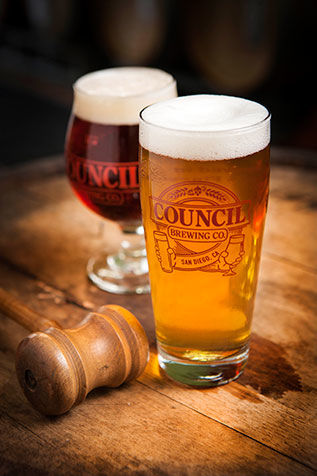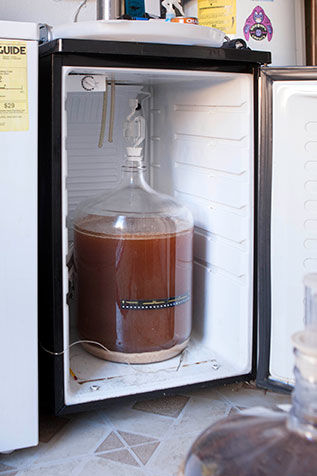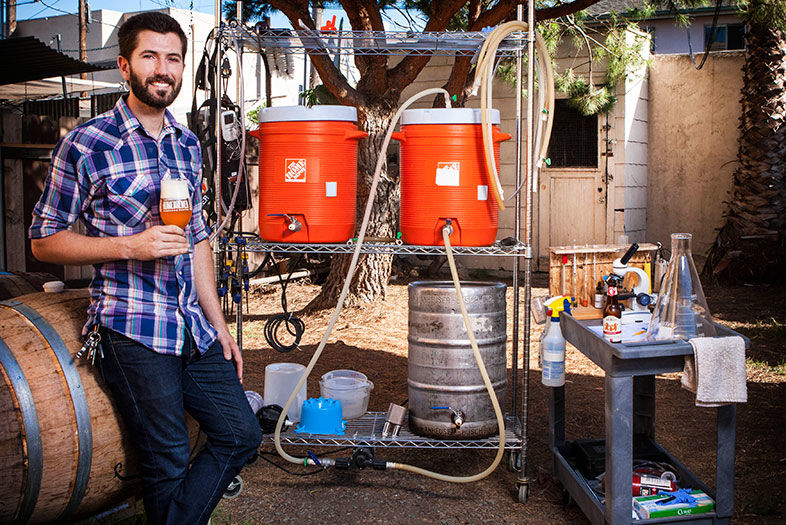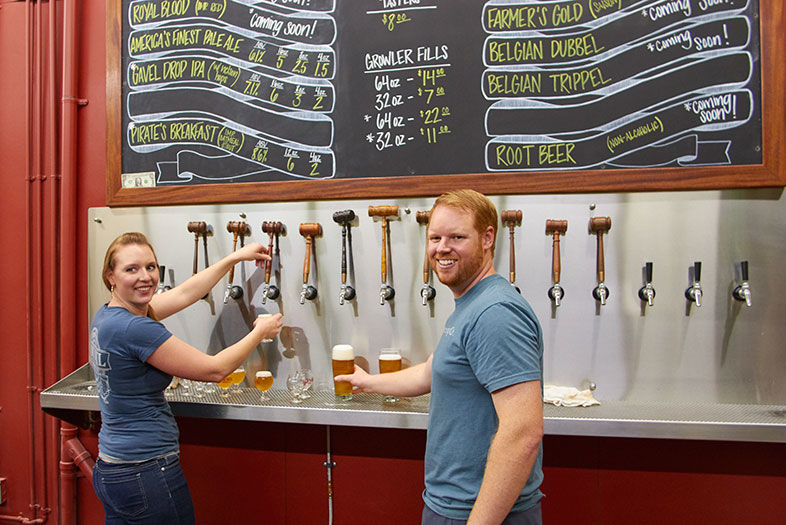Homebrewing by the numbers
1.2 million homebrewers in the United States. More than 30 percent are in Western states.
40 – Average age of
the American homebrewer
78 percent of homebrewers are married or in a domestic partnership
80 percent shop online for homebrewing supplies, in addition to in-store
43 percent of homebrewing supply shops have been open three years or less
*Source: American Homebrewers Association
Garett Redelings began brewing five years ago when his wife, Patty, gave him an extract kit for his birthday. The Burlingame resident, who works as a salesman by day, was always the cook in the family and he liked beer, so the gift was a good fit. He quickly transitioned to all-grain brewing, joined the American Homebrewing Association, and turned a few friends on to the hobby. And like many homebrewers, Redelings sometimes pictures himself brewing professionally. “I fantasize,” he says. “It’s hard not to have that dream. So many other people around you are opening nano-breweries and making a go of it.”
Indeed. Today, San Diego has 93 breweries in operation and a barrel’s worth set to open in the next year.
The influence of homebrewing provides a refreshing take on business in an age of corporate farms and biotech giants. Like the early days of radio, aviation, or personal computers, the craft beer industry is one of the few—with the possible exception of drones—still growing on the experience, talent, and knowledge of hobbyists and home tinkerers.
In 1978, President Jimmy Carter signed bill HR 1337, which essentially made homebrewing legal. Soon the art of homebrewing emerged, spawning breweries and brewpubs that laid the foundation for our rising beer scene, including Karl Strauss’ Old Columbia brewpub (1989), Mission Brewery (1989), La Jolla Brewing Company brewpub (1990), Pizza Port Brewing Company brewpub in Carlsbad (1992), Ballast Point in Linda Vista (1996), Coronado Brewing Company brewpub (1996), and Stone Brewing Company (1996).
QUAFF (Quality Ale and Fermentation Fraternity), San Diego’s oldest, most awarded, and largest homebrew club, was officially inducted in 1994, before some of the city’s best-recognized breweries had even started fermenting malts and barley. With about 360 members, QUAFF is the second- or third-largest homebrew club in the country. Members include both men and women; a number are recent college grads. More than half hold day jobs in the sciences. The American Homebrewers Association (the national authority on homebrewing) has named QUAFF Club of the Year.

Homebrewing in San Diego
Council Brewing Company was born out of the passion of two local homebrewers | Photography by Paul Body
Paul Sangster, a member and the owner of Rip Current Brewing in San Marcos, won the National Homebrew Competition Ninkasi Award in 2011—given to the brewer whose beer receives the most points across all beer styles. Kelsey McNair, a decorated homebrewer turned pro, snagged one of the top two spots the last three years in the IPA category, often considered the toughest due to the high volume of entries (there were 851 in 2014). Members have gone on to start a number of breweries and tap rooms, including Stein’s Neighborhood Pub, The Ugly Dog, Downtown Johnny Brown’s, Intergalactic Brewing Company, Benchmark Brewing, Societe Brewing Company, Fall Brewing, and AleSmith Brewing Company. In the spirit of 21st-century collaboration, Benchmark posts recipes online and invites the community to discuss on social media, using the hashtag #BenchmarkTrailCrew.
Along with QUAFF, there are about five other active homebrew clubs in San Diego: Mash Heads, Foam on the Brain, Society of Barley Engineers, Barley Literates, and North County Homebrewers Association. Larry Stein, president of QUAFF, estimates there are thousands of homebrewers in San Diego. The two industries work symbiotically; collaborations with professional brewers run rampant, and there are a number of competitions to showcase great homemade beer. QUAFF hosts America’s Finest City Homebrew Competition, welcoming national entries across 31 beer styles. Each year, Stone Brewing Co. hosts a homebrew competition, whose winners get to brew their recipes in Stone’s brewhouse. Chris Banker most recently won the competition with his Xocoveza Mocha Stout, now available for a limited time on draft and in 22-ounce bottles.

Homebrewing in San Diego
One of Thornton’s homebrews ferments in a refrigerator near his laundry room | Photography by Paul Body
Winning these competitions can catapult homebrewers to professionals. Ask McNair, who won Stone’s contest in 2010 with his session IPA, which was then distributed to 26 states across the U.S. “That was the moment I thought I should start getting a business plan together to open a brewery,” he says. That brewery is North Park Beer Company (set to open next year).
Some of the city’s best brewers can trace their beginnings back to what was once a humble hobby. Bill Batten, senior brewer at AleSmith, started homebrewing in 2000. Batten forwent the traditional method of using a homebrew kit, instead creating his own mash with supplies from a local homebrew mart. Starting with a bucket, some grains, and a kettle, Batten went at it in his kitchen. Eventually he volunteered at AleSmith, where his passion turned into a viable career.
“Most people start with a kit or a simple extract recipe,” explains Stein. These extract recipes make for a shorter brew day by omitting the mash. “A lot of people start on the kitchen stove. After their first boil-over, and the associated major mess, they get a turkey frying kit and do it in the backyard,” Stein continues. They generally do a few extract beers, then progress to extract with steeped grains, and then on to all-grain brewing.
McNair and Batten credit the huge community of certified beer judges with enhancing our city’s beer scene. Batten says the Beer Judge Certification Program “teaches you about beer styles, about processes and off-flavors, the nitty-gritty to be a better brewer.” At many beer competitions throughout the city, professional brewers toss their homemade creations into the ring. “That’s what has really driven a lot of specialties and unique styles we see in San Diego,” Batten explains. “Commercial brewers also homebrew. The two industries work so well together. It’s a hand-in-hand thing.”
One brewer who first learned to taste, then brew, was Curtis Chism; he and wife Liz opened Council Brewing in Kearny Mesa four months ago. The couple performed extensive research before homebrewing together, joined QUAFF, and got certified as beer judges to critique their own brew. Eventually their beers started receiving medals at local competitions and the dream of professionally brewing quickly fermented into a reality. They even got the opportunity to intern with Mike Hess while he was still in the nano-brewery phase of Mike Hess Brewing.

George Thornton
George Thornton’s backyard setup sits just over the fence from The Homebrewer supply shop he opened in North Park | Photography by Paul Body
George Thornton’s backyard setup sits just over the fence from The Homebrewer supply shop he opened in North Park | Photography by Paul Body
The number of places where homebrewers can hunt for supplies has grown too. Ballast Point’s Home Brew Mart, a homebrew pioneer, has been providing homebrewers with recipes, glass fermenters, and copper coil immersion wort chillers since 1992. George Thornton opened The Homebrewer (30th Street and El Cajon Boulevard) in 2012. Thornton and manager Chris Manzi lived on the same street in high school and started brewing together 10 years ago. An interest in beer led Thornton to open the supply store and, he jokes, “No one was hiring history professors.”
Thornton thinks a great beer city needs an educated drinker. By actually taking a crack at brewing, homebrewers are able to appreciate good beer on a deeper level. Thornton hopes to keep the passion going by opening his new tasting room, set to open in November. The room will teach craft beer novices and veterans alike by brewing the same beer with different yeasts or hops. “The homebrewing community serves as an incubator for professional production,” Thornton says. “But there’s a push and pull, with both industries pushing each other to be better.”
And sometimes it’s the wife who’s pushing. Garett Redelings says his wife, Patty, “is my biggest fan and also my fiercest critic when it comes to the beer I make. But judging has enhanced and furthered her appreciation for beer. Her love for beer has actually expanded because of this phenomenon that is homebrewing.”

Homebrewing in San Diego
PARTNER CONTENT
Liz and Curtis Chism at their newly opened Council Brewing Company | Photography by Tim Stahl

















